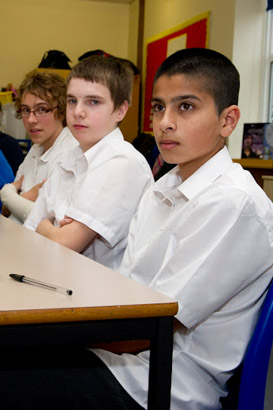
There are key differences between classrooms and learning areas in special schools and mainstream schools.
These differences relate to the range and level of pupil need.
Consider how you might teach English to a class in a mainstream school.
Think about pace, language, class size and amount of differentiation.
An English lesson
Compare your mainstream English lesson with the special school lesson featured in these videos.
What differences you can identify between them?
What challenges are there in planning for a whole class in a special school setting?
-
 English class: Assessment
English class: Assessment
for learning3:13 -
 English class: Differentiation4:48
English class: Differentiation4:48

Key differences you may have identified in the clips relate to the:
- Numbers of pupils in a lesson
- Pupil/staff ratios
- Pace of the lesson
- Level of language used
- Use of other adults to enable pupils to achieve the learning outcomes and to make progress
- Repetition of key vocabulary and tasks by staff
- Level of differentiation, and
- Use of differentiated materials to scaffold the tasks.

- There are differences between teaching English in a mainstream as opposed to a special school setting but there are also similarities.
- Most differences relate to 'how to teach' rather than 'what to teach'
- Both settings will use the National Curriculum and assess carefully where children's attainment is in relation to it. In special schools, some children will be working below national curriculum level 1.
- Both settings will plan for the range of children. In mainstream, children are often grouped according to ability. In a special school, children are more likely to be organised according to their needs.
- In a special school setting, planning will be more individual, particularly in classes where pupils have more complex needs.
An English lesson
In the special school depicted in the video, the teacher has planned for a Year 8 group whose ability range is from P6 through to L3 of the national curriculum. Here is her lesson plan:
-
 English class: Assessment for learning3:13
English class: Assessment for learning3:13 -
 English class: Differentiation4:48
English class: Differentiation4:48
Watch the clips of the English lesson in a special school again and identify:
- The methods employed by the teacher during the lesson to differentiate the work appropriately, and
- Which children are working below level 1 of the national curriculum and, as the lesson unfolds, how the teacher plans to include the pupils working at this level in the activity.
The teacher differentiates by:
- Outcome (what is expected of the pupil)
- How pupils are grouped
- Task (adapting the complexity)
- Questioning (style and complexity), and
- Amount of support.
Children working at p-levels had symbols to support the language used. They sequenced the instructions and then went to the kitchen to make a jam sandwich following those instructions.
Children working at level 1 used a writing frame. They selected key words from a word bank at the bottom of the page.
Children working at levels 2A up to level 3 worked more independently. They were expected to use time connectives, to write
in sentences and to read through their work to check that everything was in the correct sequence.

Recognising and Planning for Special Needs in the Early Years (particularly Ch8) Chris Dukes and Maggie Smith
Sage: 2009
Planning the Curriculum for Pupils with Special Educational Needs, A Practical Guide David Fulton: 2004
Ofsted Inspection Framework 2012
Inclusion, does it matter where pupils are taught (Ofsted 2006)
Special education needs and disability review (Ofsted 2010)